Today’s four-image NAVCAM montage comprises images taken on 31 August from a distance of 61 km from comet 67P/C-G.
NAVCAM image sequences are now being taken as small 2 x 2 rasters, such that roughly one quarter of the comet is seen in the corner of each of the four images. The four images are taken over an approximately 20 minute period, meaning that there is some motion of the spacecraft and rotation of the comet between the images. As a result, making a clean mosaic out of the four images is not simple.
Thus, for the purpose of this montage, the four images are shown separated by black borders. There is some overlap between adjacent frames, so that some features appear in more than one image (see CometWatch update post for more about the reasons why NAVCAM images are being taken this way).
The images have been cleaned to remove the more obvious bad ‘pixel pairs’ and cosmic ray artefacts, intensities have been scaled to show a wide range of features, and the montage has been cropped to remove most of the black space around the comet. The dark feature in the centre is an imaging artefact.
In addition, we are also providing the individual JPEGs of the four full-frame ‘corners’ (click each image below for the full 1024 x 1024 frames), and warmly invite you to create your own mosaics and share them with us. You are welcome to post them on your personal profiles with the ESA/Rosetta/NAVCAM credit line, and share a link to your work in the comments box below, so that we have the possibility to follow up with you and eventually post your efforts on this blog.
We look forward to seeing what you come up with!

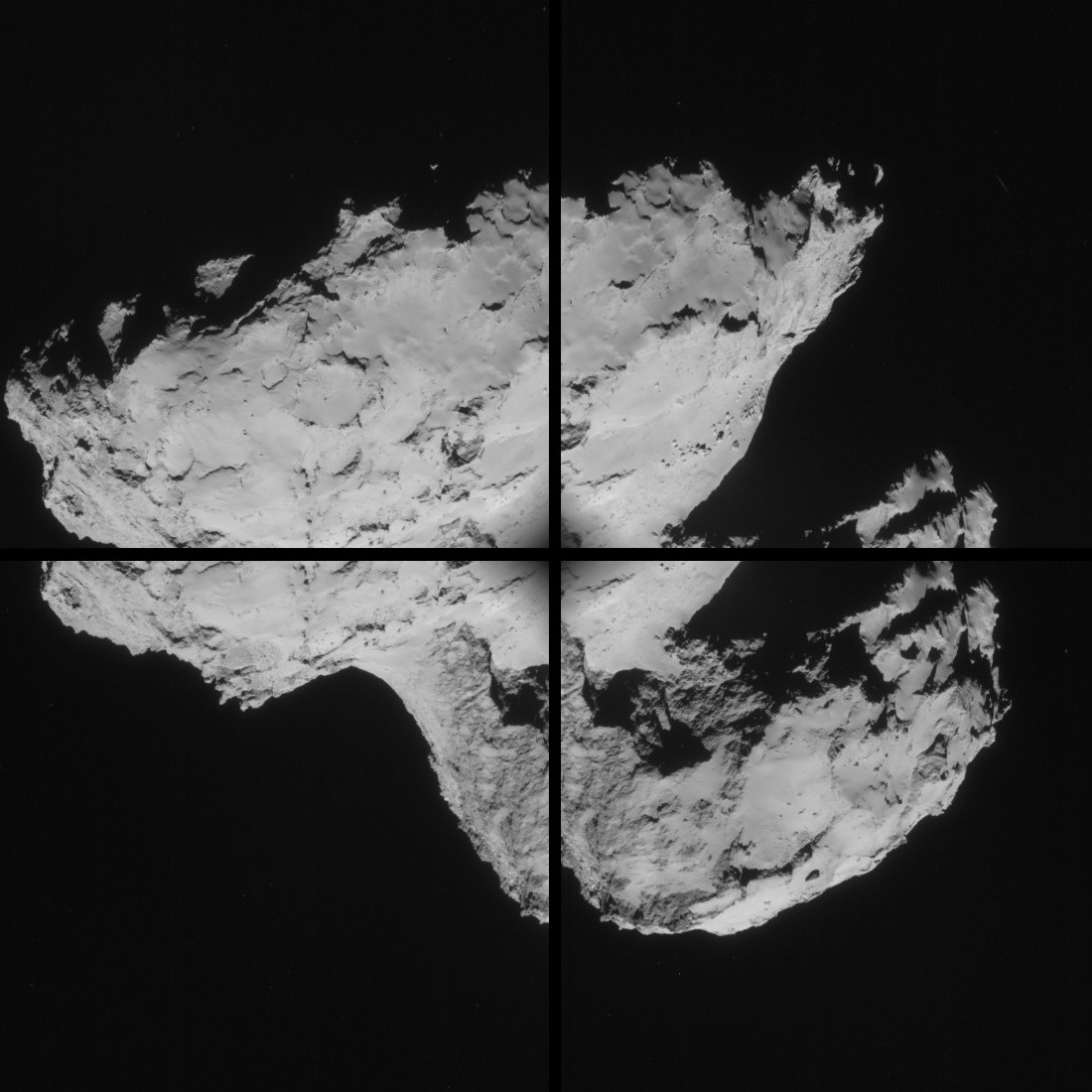
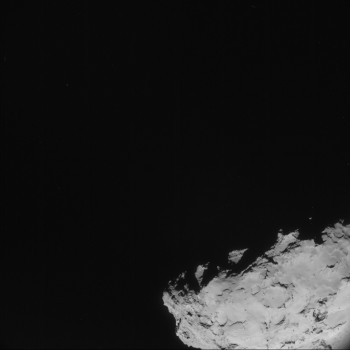
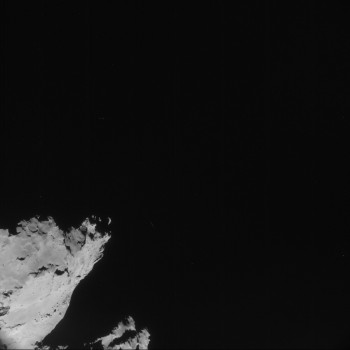
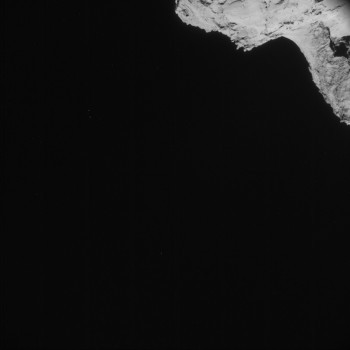
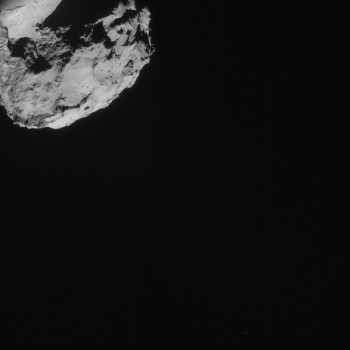








Discussion: 52 comments
“The dark feature in the centre is an imaging artefact.” – I am pretty sure that a lot of space nerds and image manipulators know what “vignetting” and “flat field” are, so… could you provide us with any NAVCAM flat fields?
Hi Rosetta Team !
I was waiting since months to do that 🙂
And here we go :
https://www.db-prods.net/blog/wp-content/uploads/2014/09/ROS_CAM1_310814_pano.jpg
Stitched with Hugin, post-prod in Gimp.
Keep up sending us images like this, I’m sure amateur like me will enjoy to have their hand on it 😉
Damia
Bravissima, Damia !
Je ne suis pas surpris de te voir répondre la première !
Olivier (cf vikingmars sur UMSF) ne sera certainement pas loin…
Nice work… any chance of adding a scale (km) and image data (pixels/m)?
Approx 4 metres resolution and the comet is 4 KM by 3.5 KM.
Amazing work there Damia 😀
Hello Rosetta Team,
the image is rotated and enlarged to 200%..
https://www.raumfahrer.net/forum/smf/index.php?action=media;sa=item;in=33502
Gertrud
I gave it a try using Hugin with a fisheye projection. It’s at https://www.unmannedspaceflight.com/index.php?showtopic=7872&pid=212542&st=270&#entry212542
Great work Steve M.
Looks like a sphinx.
a lioness sphinx.
Assembled in Microsoft ICE:
https://www.pictureshack.us/images/4520_ROS_CAM_stitch.jpg
Credit: ESA/Rosetta/NAVCAM/M. Kakitsev
Interactive version at Photosynth: https://photosynth.net/view.aspx?cid=33ecc417-2e87-4dc7-855a-929a58863981
By the way, dear ESA people, it would be nice to see R/G/B filtered images, for a true-colour composite of the comet 🙂
Thank you! This is wonderful imaging fodder.
–Bill
Many thanks one and all for your excellent work on these images.
Clive
Well done. If ESA delivers more of this on a regularly basis we might soon get what we want.
Thanks for sharing NAVCAM team.
See the cells.
(Still can’t see the bees)
😉
https://rasterbator.net/
“Wall art from any image
The Rasterbator enlarges images to multiple pages. Print and combine them into huge posters.”
may be useful.
By looking into some mosaics, it looks like an Alien 🙂
Wasn’t supposed to be at 50 km from the comet by the time the pictures were taken?
The actual distance varies by a few kilometres from day to day depending on where the spacecraft is along the trajectory.
Likely it is not exactly what you were
asking for. But here comes my version:
comet 67p, shortly after disintegration
into six pieces.
https://www.althofer.de/67p-disintegration.jpg
Ingo.
here’s my aug 31 navcam mosaic and story. thanks for sharing. please release more OSIRIS imagery too!
https://www.universetoday.com/114238/rosetta-now-up-close-to-comet-67p-snapping-mapping-mosaics-for-momentous-philae-landing/
Many thanks….
Can you provide spacecraft position relative to the coordinate system of the comet body, i.e., sub-camera longitude and latitude? It’s hard to judge the angles by eye.
–Richard
At least the surface looks more void than solid.
Here is my resulting stitched image of the comet 67P:
https://www.flickr.com/photos/alpi-costerni/15113184425/in/photostream/
Also me wanted to participate.
This is easy as drinking a glass of water for who does this for over 20 years, but with dozens or hundreds of High Res shots and get to the end of patient work, posters with Gigapixel resolution!
Here my version of 67P rom Rosetta/NAVCAM
https://i.imgur.com/ktpCKYS.jpg
Adam
It would be brilliant if you have any 3d pairs to generate a 3d model
“Jean Hopkins says:
02/09/2014 at 07:24
It would be brilliant if you have any 3d pairs to generate a 3d model”
Her you go ! This is fake 3D but it’s nice, see yourself.
https://oi60.tinypic.com/2mrcjys.jpg
Adam
Nice! How did you do? which software did you use?
Hi Rosetta Team,
thanks for these images.
Here’s our color version (not real of course).
A contrast colorization for a different view on details https://flic.kr/p/p1E5QH
Here is my version.
https://drive.google.com/file/d/0B6Ho_4s88OOmalM3ZGpZT2RFYXM/edit?usp=sharing
rosetta traveled for 10 years in an amazing speed. If you had an atomic clock on board it was too delayed now.
There’s quite a lot of high res images out now.
I wonder if anyone has managed to reconstitute a high-res 3D model of the comet? I’ve seen some crude versions but one with all the sharp and spiky bits would be awesome.
Anyone up to the challenge? I’d love to 3D print it…
my version of Rosetta:
https://www.facebook.com/photo.php?fbid=557903430981011&set=a.112642325507126.14472.100002840765308&type=1
PTGui+Photoshop
here’s our “heads up” version just featured at the BBC:
https://www.bbc.com/news/science-environment-29036303
Hi, and very nice work ESA. But, how can join the picture as there are dark spots in the corners?
Astronomos,
you could try using a spot-flashlight! 😉
what do you mean?
Those small dark spots …
(that is lens vignetting, or something like this, on the front of the optics),
… are … is a not big problem for the usual manual or automatic stitching and post production with a computer…
You have not to stitch 4 pieces of printed paper! Hope you can understand now or later.
Moreover, with the abundance present among the 4 frames the dark spots are almost completely cut off.
But now I say to ESA:
the abundance here in this case of these 4 frames, is under the recomandable limit for producing good mosaics.
I recommend, if possible, to give instructions to Rosetta to do shots that include at least 20% of common parts between adjacent shots!
10% is not enough, 20% is good enough, 30 … 40 is the ideal.
You divide the image with a flat field. (Google flatfield correction)
In this case you will have to estimate the flatfield. That will be easier to do when we have more of these corner images. You can then average them and get a better estimate of the vignetting curve.
This obviously has to be done in linear space and not sRGB. We really do not know what gamma curve these raw previews are in… One would guess that they have an srgb curve applied or perhaps only a simple gamma curve.
The cassini raw previews are “auto leveled” but these seem to be rather untouched. Perhaps just a bit of dark current removal.
Many amazing pictures here,
it is simply beautifull to look at !
Thank you .
Pff that was waaay too easy. Try this:
https://three.flash-gear.com/npuz/puz.php?c=v&id=4021780&k=44560425
🙂
(from 16.August)
I’m building a shapemodel…
…With all the pointy bits 🙂
https://mattias.malmer.nu/wp-content/uploads/2014/08/trim.21B8694C-303A-490B-BA7D-B683D8388A36.mov
Reverences to your work Mattias Malmer.
Very interesting, bravo Mattias!
Here is my take using PTGui for stitching and Gimp for post-processing:
https://www.flickr.com/photos/105035663@N07/14939242960/
Sorry Thomas, but this is not a so good stitching.
There is a visible junction defect in the central area where there are duplicate, blurred-faded elements.
Similar defect is also present in at least 2 other images of others, that I’ve seen on the links reported here above.
Thank you!
It is coming along nicely. Just waiting for some more images. Another osiris stereo pair would do wonders…
/M
Since many days we are onle getting NAVCAM images. But the OSIRIS camera should make much more detailed shots from the surface.
I would like to see a detail of the surface structure from OSIRIS !
Maybe in the new media calling.
Its amazing looking and filling ( with a machine ) an object from such a distance and age, Possibly hundreds of thousands of years old, its is thrilling
Matthias, a truly magnificent 3d model, thanks for sharing
https://scontent-a-ord.xx.fbcdn.net/hphotos-xpa1/v/t1.0-9/s720x720/10533435_305037886335766_8246969877989663936_n.jpg?oh=3a9dcbc6bdde9d56cf6bed5b2ac7996d&oe=5487956E